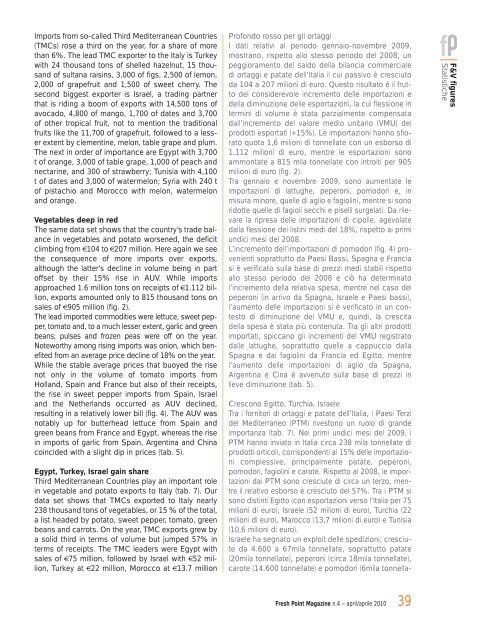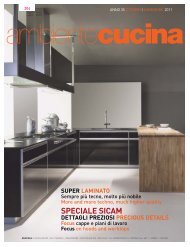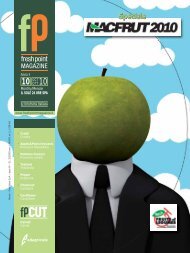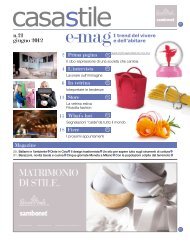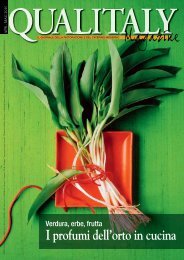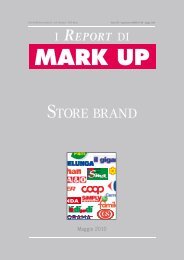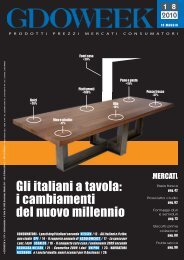Fresh Point Magazine - B2B24 - Il Sole 24 Ore
Fresh Point Magazine - B2B24 - Il Sole 24 Ore
Fresh Point Magazine - B2B24 - Il Sole 24 Ore
You also want an ePaper? Increase the reach of your titles
YUMPU automatically turns print PDFs into web optimized ePapers that Google loves.
Imports from so-called Third Mediterranean Countries<br />
(TMCs) rose a third on the year, for a share of more<br />
than 6%. The lead TMC exporter to the Italy is Turkey<br />
with <strong>24</strong> thousand tons of shelled hazelnut, 15 thousand<br />
of sultana raisins, 3,000 of figs, 2,500 of lemon,<br />
2,000 of grapefruit and 1,500 of sweet cherry. The<br />
second biggest exporter is Israel, a trading partner<br />
that is riding a boom of exports with 14,500 tons of<br />
avocado, 4,800 of mango, 1,700 of dates and 3,700<br />
of other tropical fruit, not to mention the traditional<br />
fruits like the 11,700 of grapefruit, followed to a lesser<br />
extent by clementine, melon, table grape and plum.<br />
The next in order of importance are Egypt with 3,700<br />
t of orange, 3,000 of table grape, 1,000 of peach and<br />
nectarine, and 300 of strawberry; Tunisia with 4,100<br />
t of dates and 3,000 of watermelon; Syria with <strong>24</strong>0 t<br />
of pistachio and Morocco with melon, watermelon<br />
and orange.<br />
Vegetables deep in red<br />
The same data set shows that the country’s trade balance<br />
in vegetables and potato worsened, the deficit<br />
climbing from €104 to €207 million. Here again we see<br />
the consequence of more imports over exports,<br />
although the latter’s decline in volume being in part<br />
offset by their 15% rise in AUV. While imports<br />
approached 1.6 million tons on receipts of €1.112 billion,<br />
exports amounted only to 815 thousand tons on<br />
sales of €905 million (fig. 2).<br />
The lead imported commodities were lettuce, sweet pepper,<br />
tomato and, to a much lesser extent, garlic and green<br />
beans; pulses and frozen peas were off on the year.<br />
Noteworthy among rising imports was onion, which benefited<br />
from an average price decline of 18% on the year.<br />
While the stable average prices that buoyed the rise<br />
not only in the volume of tomato imports from<br />
Holland, Spain and France but also of their receipts,<br />
the rise in sweet pepper imports from Spain, Israel<br />
and the Netherlands occurred as AUV declined,<br />
resulting in a relatively lower bill (fig. 4). The AUV was<br />
notably up for butterhead lettuce from Spain and<br />
green beans from France and Egypt, whereas the rise<br />
in imports of garlic from Spain, Argentina and China<br />
coincided with a slight dip in prices (tab. 5).<br />
Egypt, Turkey, Israel gain share<br />
Third Mediterranean Countries play an important role<br />
in vegetable and potato exports to Italy (tab. 7). Our<br />
data set shows that TMCs exported to Italy nearly<br />
238 thousand tons of vegetables, or 15 % of the total,<br />
a list headed by potato, sweet pepper, tomato, green<br />
beans and carrots. On the year, TMC exports grew by<br />
a solid third in terms of volume but jumped 57% in<br />
terms of receipts. The TMC leaders were Egypt with<br />
sales of €75 million, followed by Israel with €52 million,<br />
Turkey at €22 million, Morocco at €13.7 million<br />
Profondo rosso per gli ortaggi<br />
I dati relativi al periodo gennaio-novembre 2009,<br />
mostrano, rispetto allo stesso periodo del 2008, un<br />
peggioramento del saldo della bilancia commerciale<br />
di ortaggi e patate dell’Italia il cui passivo è cresciuto<br />
da 104 a 207 milioni di euro. Questo risultato è il frutto<br />
del considerevole incremento delle importazioni e<br />
della diminuzione delle esportazioni, la cui flessione in<br />
termini di volume è stata parzialmente compensata<br />
dall’incremento del valore medio unitario (VMU) dei<br />
prodotti esportati (+15%). Le importazioni hanno sfiorato<br />
quota 1,6 milioni di tonnellate con un esborso di<br />
1.112 milioni di euro, mentre le esportazioni sono<br />
ammontate a 815 mila tonnellate con introiti per 905<br />
milioni di euro (fig. 2).<br />
Tra gennaio e novembre 2009, sono aumentate le<br />
importazioni di lattughe, peperoni, pomodori e, in<br />
misura minore, quelle di aglio e fagiolini, mentre si sono<br />
ridotte quelle di fagioli secchi e piselli surgelati. Da rilevare<br />
la ripresa delle importazioni di cipolle, agevolate<br />
dalla flessione dei listini medi del 18%, rispetto ai primi<br />
undici mesi del 2008.<br />
L’incremento dell’importazioni di pomodori (fig. 4) provenienti<br />
soprattutto da Paesi Bassi, Spagna e Francia<br />
si è verificato sulla base di prezzi medi stabili rispetto<br />
allo stesso periodo del 2008 e ciò ha determinato<br />
l’incremento della relativa spesa, mentre nel caso dei<br />
peperoni (in arrivo da Spagna, Israele e Paesi bassi),<br />
l’aumento delle importazioni si è verificato in un contesto<br />
di diminuzione del VMU e, quindi, la crescita<br />
della spesa è stata più contenuta. Tra gli altri prodotti<br />
importati, spiccano gli incrementi del VMU registrato<br />
dalle lattughe, soprattutto quelle a cappuccio dalla<br />
Spagna e dai fagiolini da Francia ed Egitto, mentre<br />
l’aumento delle importazioni di aglio da Spagna,<br />
Argentina e Cina è avvenuto sulla base di prezzi in<br />
lieve diminuzione (tab. 5).<br />
Crescono Egitto, Turchia, Israele<br />
Tra i fornitori di ortaggi e patate dell’Italia, i Paesi Terzi<br />
del Mediterraneo (PTM) rivestono un ruolo di grande<br />
importanza (tab. 7). Nei primi undici mesi del 2009, i<br />
PTM hanno inviato in Italia circa 238 mila tonnellate di<br />
prodotti orticoli, corrispondenti al 15% delle importazioni<br />
complessive, principalmente patate, peperoni,<br />
pomodori, fagiolini e carote. Rispetto al 2008, le importazioni<br />
dai PTM sono cresciute di circa un terzo, mentre<br />
il relativo esborso è cresciuto del 57%. Tra i PTM si<br />
sono distinti Egitto (con esportazioni verso l’Italia per 75<br />
milioni di euro), Israele (52 milioni di euro), Turchia (22<br />
milioni di euro), Marocco (13,7 milioni di euro) e Tunisia<br />
(10,6 milioni di euro).<br />
Israele ha segnato un exploit delle spedizioni, cresciute<br />
da 4.600 a 67mila tonnellate, soprattutto patate<br />
(20mila tonnellate), peperoni (circa 18mila tonnellate),<br />
carote (14.600 tonnellate) e pomodori (6mila tonnella-<br />
<strong>Fresh</strong> <strong>Point</strong> <strong>Magazine</strong> n.4 – april/aprile 2010<br />
39<br />
F&V figures<br />
Statistiche


